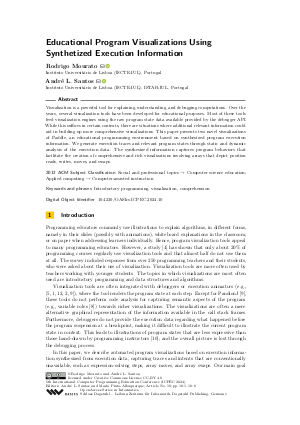Educational Program Visualizations Using Synthetized Execution Information
Authors
Rodrigo Mourato  ,
André L. Santos
,
André L. Santos 
-
Part of:
Volume:
5th International Computer Programming Education Conference (ICPEC 2024)
Part of: Series: Open Access Series in Informatics (OASIcs)
Part of: Conference: International Computer Programming Education Conference (ICPEC) - License:
 Creative Commons Attribution 4.0 International license
Creative Commons Attribution 4.0 International license
- Publication Date: 2024-09-25
File

PDF
OASIcs.ICPEC.2024.10.pdf
- Filesize: 0.65 MB
- 8 pages
Document Identifiers
Subject Classification
ACM Subject Classification
- Social and professional topics → Computer science education
- Applied computing → Computer-assisted instruction
Keywords
- Introductory programming
- visualization
- comprehension
Metrics
- Access Statistics
-
Total Accesses (updated on a weekly basis)
0PDF Downloads0Metadata Views
Abstract
Visualization is a powerful tool for explaining, understanding, and debugging computations. Over the years, several visualization tools have been developed for educational purposes. Most of these tools feed visualization engines using the raw program state data available provided by the debugger API. While this suffices in certain contexts, there are situations where additional relevant information could aid in building up more comprehensive visualizations. This paper presents two novel visualizations of Paddle, an educational programming environment based on synthesized program execution information. We generate execution traces and relevant program states through static and dynamic analysis of the execution data. The synthesized information captures program behaviors that facilitate the creation of comprehensive and rich visualizations involving arrays that depict position reads, writes, moves, and swaps.
Cite As Get BibTex
Rodrigo Mourato and André L. Santos. Educational Program Visualizations Using Synthetized Execution Information. In 5th International Computer Programming Education Conference (ICPEC 2024). Open Access Series in Informatics (OASIcs), Volume 122, pp. 10:1-10:8, Schloss Dagstuhl – Leibniz-Zentrum für Informatik (2024)
https://doi.org/10.4230/OASIcs.ICPEC.2024.10
BibTex
@InProceedings{mourato_et_al:OASIcs.ICPEC.2024.10,
author = {Mourato, Rodrigo and Santos, Andr\'{e} L.},
title = {{Educational Program Visualizations Using Synthetized Execution Information}},
booktitle = {5th International Computer Programming Education Conference (ICPEC 2024)},
pages = {10:1--10:8},
series = {Open Access Series in Informatics (OASIcs)},
ISBN = {978-3-95977-347-8},
ISSN = {2190-6807},
year = {2024},
volume = {122},
editor = {Santos, Andr\'{e} L. and Pinto-Albuquerque, Maria},
publisher = {Schloss Dagstuhl -- Leibniz-Zentrum f{\"u}r Informatik},
address = {Dagstuhl, Germany},
URL = {https://drops.dagstuhl.de/entities/document/10.4230/OASIcs.ICPEC.2024.10},
URN = {urn:nbn:de:0030-drops-209799},
doi = {10.4230/OASIcs.ICPEC.2024.10},
annote = {Keywords: Introductory programming, visualization, comprehension}
}
Author Details
References
- G. Cattaneo, P. Faruolo, U.F. Petrillo, and G.F. Italiano. Jive: Java interactive software visualization environment. In 2004 IEEE Symposium on Visual Languages - Human Centric Computing, pages 41-43, 2004. URL: https://doi.org/10.1109/VLHCC.2004.34.
- James Cross, Dean Hendrix, Larry Barowski, and David Umphress. Dynamic program visualizations: An experience report. In Proceedings of the 45th ACM Technical Symposium on Computer Science Education, SIGCSE '14, pages 609-614, New York, NY, USA, 2014. ACM. URL: https://doi.org/10.1145/2538862.2538958.
- Jeffrey K. Czyz and Bharat Jayaraman. Declarative and visual debugging in Eclipse. In Proceedings of the 2007 OOPSLA Workshop on Eclipse Technology eXchange, eclipse '07, pages 31-35, New York, NY, USA, 2007. ACM. URL: https://doi.org/10.1145/1328279.1328286.
- Essi Isohanni and Hannu-Matti Järvinen. Are visualization tools used in programming education?: By whom, how, why, and why not? In Proceedings of the 14th Koli Calling International Conference on Computing Education Research, Koli Calling '14, pages 35-40, New York, NY, USA, 2014. ACM. URL: https://doi.org/10.1145/2674683.2674688.
-
Ronit Ben-Bassat Levy, Mordechai Ben-Ari, and Pekka A. Uronen. The Jeliot 2000 program animation system. Computers and Education, 40(1):1-15, 2003.

- Cristóbal Pareja-Flores, Jamie Urquiza-Fuentes, and J. Ángel Velázquez-Iturbide. WinHIPE: an ide for functional programming based on rewriting and visualization. SIGPLAN Not., 42(3):14-23, March 2007. URL: https://doi.org/10.1145/1273039.1273042.
- Steven P. Reiss. The challenge of helping the programmer during debugging. In 2014 Second IEEE Working Conference on Software Visualization, pages 112-116, 2014. URL: https://doi.org/10.1109/VISSOFT.2014.27.
- Jorma Sajaniemi. An empirical analysis of roles of variables in novice-level procedural programs. In Proceedings of the IEEE 2002 Symposia on Human Centric Computing Languages and Environments (HCC'02), HCC '02, pages 37-, Washington, DC, USA, 2002. IEEE Computer Society. URL: http://dl.acm.org/citation.cfm?id=795687.797809.
- André L. Santos. Enhancing visualizations in pedagogical debuggers by leveraging on code analysis. In Mike Joy and Petri Ihantola, editors, Proceedings of the 18th Koli Calling International Conference on Computing Education Research, Koli, Finland, November 22-25, 2018, pages 11:1-11:9. ACM, 2018. URL: https://doi.org/10.1145/3279720.3279732.
- André L. Santos and Hugo Sousa. An exploratory study of how programming instructors illustrate variables and control flow. In Proceedings of the 17th Koli Calling Conference on Computing Education Research, Koli, Finland, November 16-19, 2017, pages 173-177, 2017. URL: https://doi.org/10.1145/3141880.3141892.
- Juha Sorva, Ville Karavirta, and Lauri Malmi. A review of generic program visualization systems for introductory programming education. ACM Transactions on Computing Education, 13(4):15.1-15.64, 2013. URL: https://doi.org/10.1145/2490822.
- Juha Sorva and Teemu Sirkiä. Uuhistle: a software tool for visual program simulation. In Proceedings of the 10th Koli Calling International Conference on Computing Education Research, Koli Calling '10, pages 49-54, New York, NY, USA, 2010. Association for Computing Machinery. URL: https://doi.org/10.1145/1930464.1930471.
- J. Ángel Velázquez-Iturbide and Antonio Pérez-Carrasco. How to use the SRec visualization system in programming and algorithm courses. ACM Inroads, 7(3):42-49, August 2016. URL: https://doi.org/10.1145/2948070.
